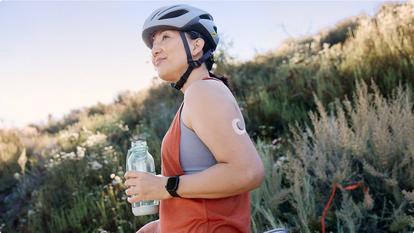Nutrition
Does drinking water help lower your blood sugar levels?
Published: May 15, 2025
Updated: Aug. 20, 2025
3 min read

The content in this article should not be taken as medical advice. Please consult with your healthcare provider regarding your individual health needs.
You’ve probably heard that staying hydrated is good for your health, but did you know it can also play a role in managing glucose levels? Water isn’t just essential for survival—it helps your body flush out excess sugar and keep your metabolism running smoothly. Let’s take a look at why hydration is a key piece of the glucose puzzle and how drinking water can help lower your blood sugar levels and support your health.

The link between hydration and glucose
When your body is well-hydrated, it can efficiently transport glucose through your bloodstream and help your kidneys remove excess sugar through urine. On the flip side, dehydration can cause glucose concentrations to rise. This isn’t because you have more glucose in your system; it’s because there’s less water to balance it out. It’s an imbalance that can lead to temporary glucose spikes and, over time, make it harder for your body to use insulin effectively.
For those managing diabetes, dehydration can exacerbate symptoms and make glucose regulation more challenging. But even if you’re not living with diabetes, staying hydrated can help keep your blood sugar levels stable and support overall metabolic function.
How much water do you really need?
Your hydration needs depend on several factors, including your body size, activity level, prescribed medications, certain health conditions, and environment. Consult with your healthcare team on personalized recommendations regarding water intake. However, general guidelines suggest:
- Men should aim for about 15.5 cups (124 ounces) of fluids per day
- Women should target around 11.5 cups (92 ounces) per day
- If you exercise frequently, live in a hot climate, or consume diuretics like caffeine, you may need even more
A quick hydration check: your urine should be light-colored. Darker urine is often a sign that you need more fluids.
When you drink matters too
Spacing out your water intake throughout the day is important, but there are a few key times when drinking water can have added benefits.
First thing in the morning
Rehydrating after a night of sleep helps jumpstart your metabolism and flush out any excess glucose.
Before meals
A glass of water before eating may help with portion control and reduce post-meal glucose spikes.
During and after exercise
Physical activity can impact glucose levels, and staying hydrated supports energy metabolism and recovery. Take water breaks during exercise and plan to stay hydrated after a workout.

Simple ways to stay hydrated
Drinking enough water doesn’t have to feel like a chore. Here are some easy ways to stay on top of your hydration:
- Carry a reusable water bottle so you always have water on hand
- Add natural flavors like lemon, cucumber, or berries if plain water feels boring
- Set reminders or use a hydration tracking app to stay consistent
- Try a smart water bottle that tracks your intake and nudges you to drink more
- Make hydration part of your routine: drink a glass of water when you wake up, before meals, and before bed.
Try it for yourself
Curious to learn how hydration affects your own glucose levels? Try these simple self-experiments.
Plan a “perfect hydration day”
Estimate your water needs and commit to hitting your target. Use a glucose biosensor like Stelo to track your glucose patterns and see if you notice any changes.
Test pre-meal hydration
Drink a glass of water before your favorite meal and compare your glucose levels to a time when you didn’t. Do you notice any differences in appetite or post-meal glucose?

Sip smarter for better balance
The bottom line is this: hydration is a small but powerful tool in glucose management. Whether you’re living with diabetes or simply looking to keep your glucose levels steady, making water a priority can support your health in meaningful ways.

Curated & reviewed by: Alexa Stelzer
RDN, CDCES, CSPO
RDN, CDCES, CSPO
Alexa Stelzer is a Clinical Digital Specialist at Dexcom, with a background in clinical dietetics and program management.
